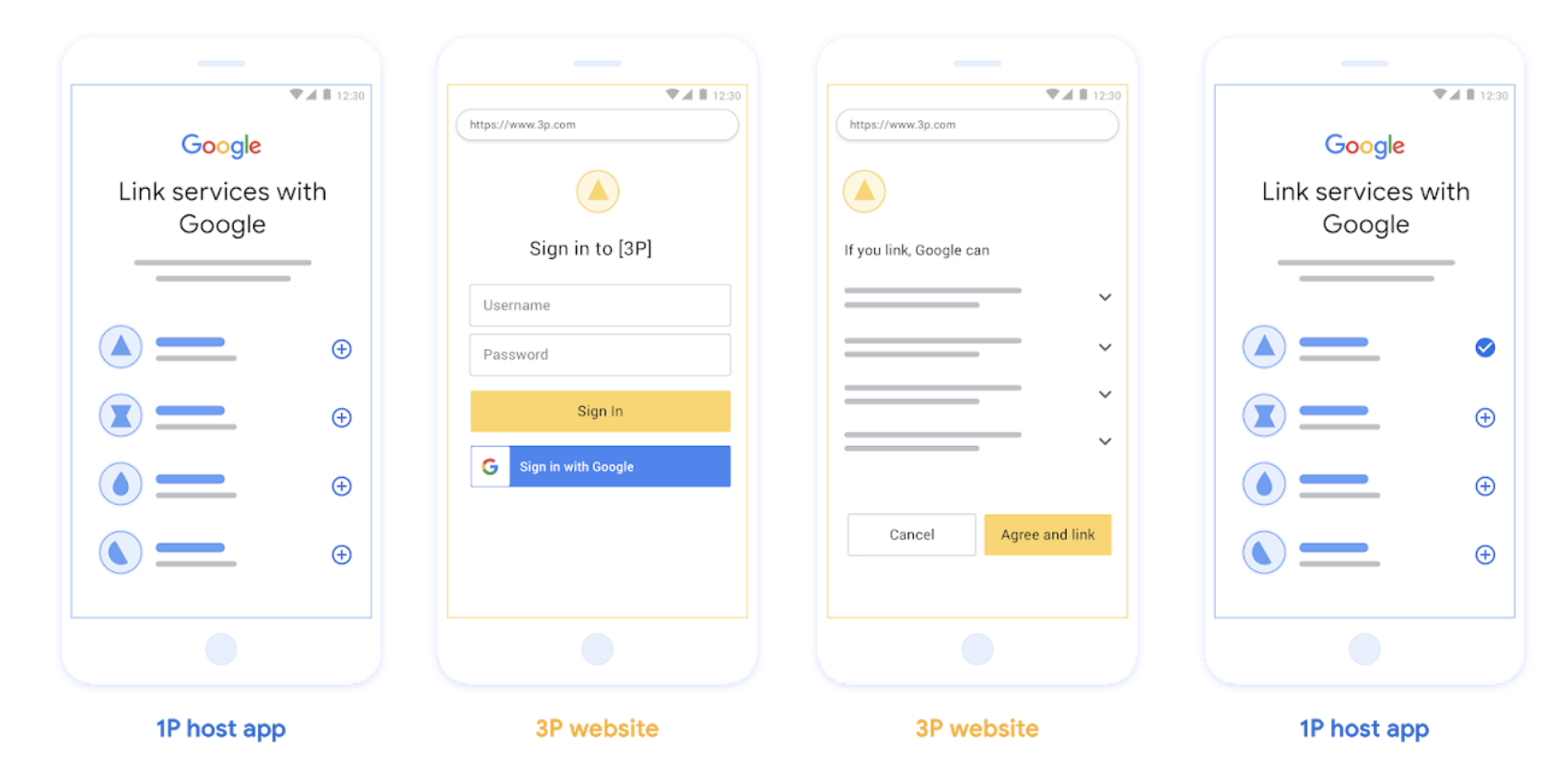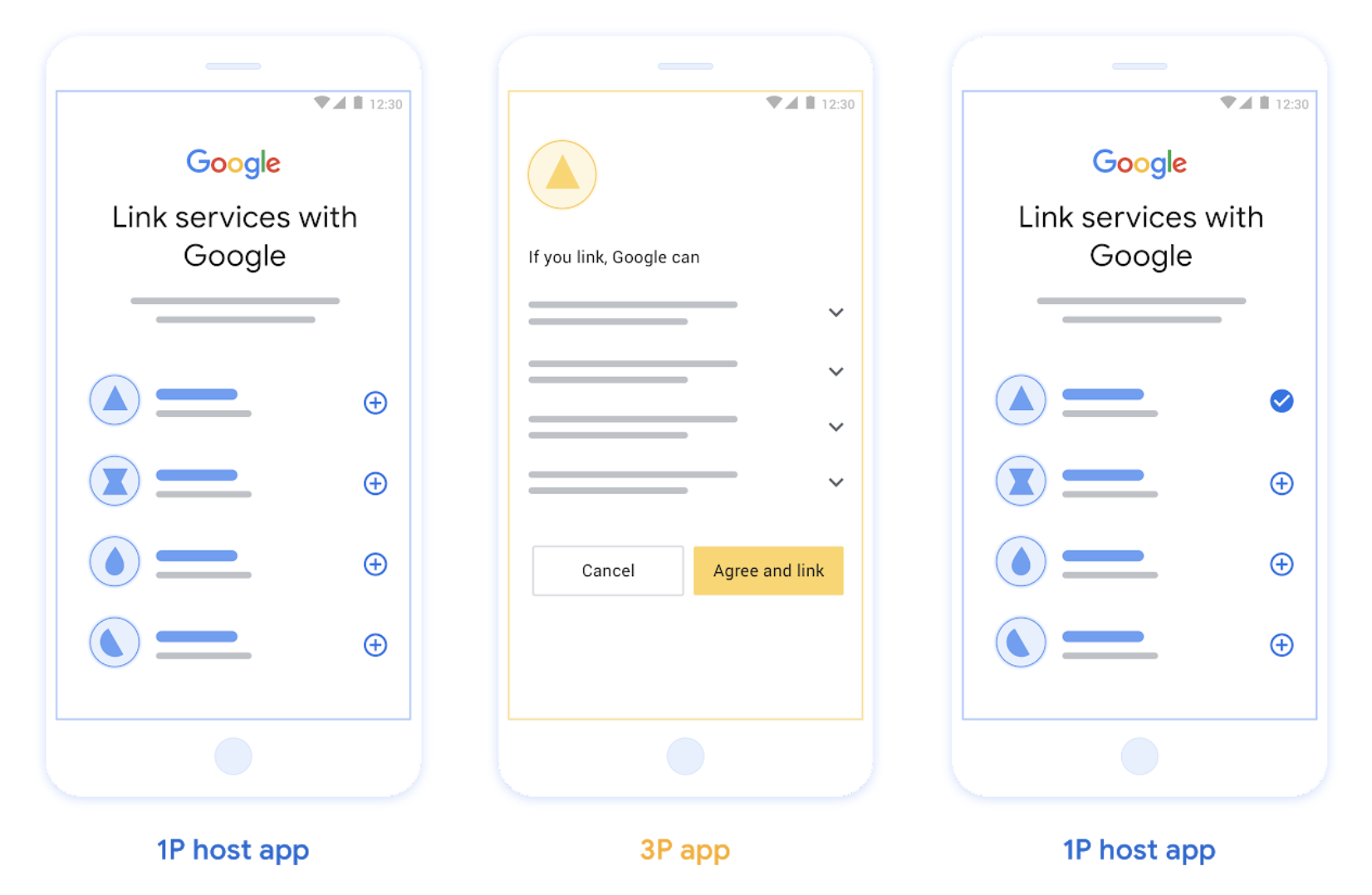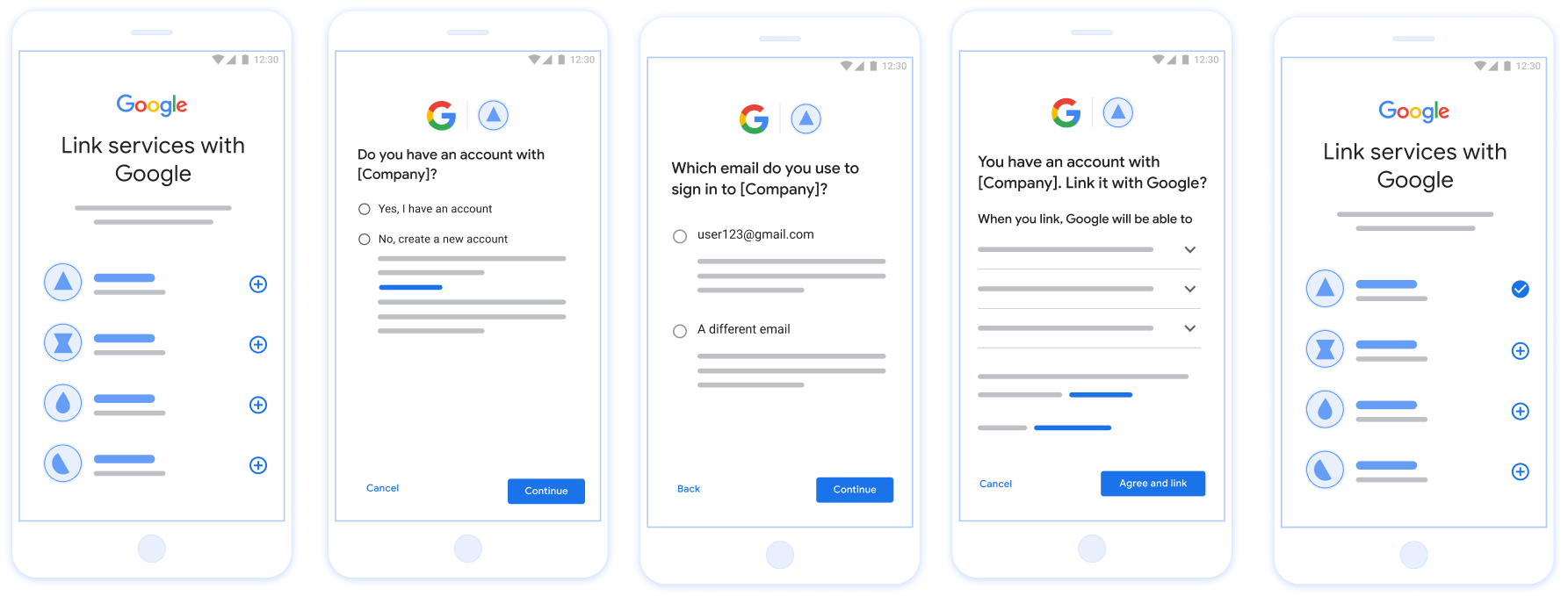계정 연결을 사용하면 Google 계정 소유자가 서비스에 빠르고 원활하며 안전하게 연결할 수 있습니다. Google 계정 연결을 구현하여 플랫폼의 사용자 데이터를 Google 앱 및 서비스와 공유할 수 있습니다.
보안 OAuth 2.0 프로토콜을 사용하면 사용자의 Google 계정을 플랫폼의 계정과 안전하게 연결하여 Google 애플리케이션과 기기에 서비스에 대한 액세스 권한을 부여할 수 있습니다.
사용자는 Google 계정 연결을 사용하여 계정을 연결하거나 연결 해제할 수 있으며, 원하는 경우 플랫폼에서 새 계정을 만들 수 있습니다.
사용 사례
Google 계정 연결을 구현하는 이유는 다음과 같습니다.
플랫폼의 사용자 데이터를 Google 앱 및 서비스와 공유합니다.
Google TV를 사용하여 동영상 및 영화 콘텐츠를 재생합니다.
Google Home 앱과 Google 어시스턴트('Hey Google, 조명 켜줘')를 사용하여 Google 스마트 홈 연결 기기를 관리하고 제어하세요.
대화형 작업(예: "Hey Google, 스타벅스에서 평소에 먹는 거 주문해 줘")을 사용하여 사용자 맞춤 Google 어시스턴트 환경과 기능을 만듭니다.
사용자가 Google 계정을 리워드 파트너 계정에 연결한 후 YouTube에서 자격요건을 충족하는 라이브 스트림을 시청하여 리워드를 받을 수 있도록 지원합니다.
가입 중에 Google 계정 프로필의 동의에 따라 공유된 데이터로 새 계정을 자동 입력합니다.
지원되는 기능
Google 계정 연결에서 지원하는 기능은 다음과 같습니다.
암시적 OAuth 연결 흐름을 사용하여 데이터를 빠르고 쉽게 공유하세요.
OAuth 연결 승인 코드 흐름으로 보안을 강화합니다.
기존 사용자를 로그인하거나 플랫폼에 Google 인증된 신규 사용자를 가입시키고, 동의를 얻은 후 간소화된 연결을 통해 데이터를 안전하게 공유하세요.
앱 플립으로 불편을 줄이세요. 신뢰할 수 있는 Google 앱에서 한 번 탭하면 인증된 Android 또는 iOS 앱이 안전하게 열리고 한 번 탭하면 사용자 동의가 부여되고 계정이 연결됩니다.
필요한 데이터만 공유하도록 맞춤 범위를 정의하여 사용자 개인 정보 보호를 개선하고, 데이터가 사용되는 방식을 명확하게 정의하여 사용자 신뢰를 높입니다.
계정 연결을 해제하여 플랫폼에 호스팅된 데이터 및 서비스에 대한 액세스 권한을 취소할 수 있습니다. 선택적 토큰 취소 엔드포인트를 구현하면 Google에서 시작한 이벤트와 동기화할 수 있으며, 교차 계정 보호 (RISC)를 사용하면 플랫폼에서 발생하는 연결 해제 이벤트를 Google에 알릴 수 있습니다.
계정 연결 흐름
Google 계정 연결 흐름에는 3가지가 있으며 모두 OAuth 기반이며 OAuth 2.0을 준수하는 승인 및 토큰 교환 엔드포인트를 관리하거나 제어해야 합니다.
연결 프로세스 중에 계정 소유자의 계정 연결 및 데이터 공유 동의를 얻은 후 개발자는 개별 Google 계정에 대한 액세스 토큰을 Google에 발급합니다.
OAuth 연결 ('웹 OAuth')
이는 사용자를 웹사이트로 연결하여 연결하는 기본 OAuth 흐름입니다. 사용자는 계정에 로그인할 수 있도록 웹사이트로 리디렉션됩니다. 로그인하면 사용자는 개발자의 서비스에서 Google과 데이터를 공유하는 데 동의합니다. 이때 사용자의 Google 계정과 서비스가 연결됩니다.
OAuth 연결은 승인 코드 및 암시적 OAuth 흐름을 지원합니다. 서비스는 암시적 흐름을 위한 OAuth 2.0 규격 승인 엔드포인트를 호스팅해야 하며 승인 코드 흐름을 사용할 때 승인 및 토큰 교환 엔드포인트를 모두 노출해야 합니다.

그림 1. 웹 OAuth를 사용하여 사용자 휴대전화에서 계정 연결
OAuth 기반 앱 전환 연결 ('앱 전환')
연결을 위해 사용자를 앱으로 보내는 OAuth 흐름입니다.
OAuth 기반 앱 전환 연결은 사용자가 인증된 Android 또는 iOS 모바일 앱과 Google 플랫폼 간에 이동할 때 제안된 데이터 액세스 변경사항을 검토하고 플랫폼의 계정을 Google 계정과 연결하는 것에 동의하도록 안내합니다. 앱 플립을 사용 설정하려면 서비스에서 승인 코드 흐름을 사용하여 OAuth 연결 또는 OAuth 기반 Google 로그인 연결을 지원해야 합니다.
앱 플립은 Android와 iOS에서 모두 지원됩니다.
작동 방식:
Google 앱이 사용자 기기에 앱이 설치되어 있는지 확인합니다.
- 앱이 발견되면 사용자는 앱으로 '전환'됩니다. 앱은 사용자로부터 계정을 Google에 연결하기 위한 동의를 수집한 후 Google 표시 경로로 '다시 전환'됩니다.
- 앱을 찾을 수 없거나 앱 전환 연결 프로세스 중에 오류가 발생하면 사용자는 간소화된 OAuth 흐름 또는 웹 OAuth 흐름으로 리디렉션됩니다.

그림 2. 앱 플립을 사용한 사용자 휴대전화의 계정 연결
OAuth 기반 간소화된 연결 ('간소화된')
OAuth 기반 Google 로그인 간소화된 연결은 OAuth 연결 위에 Google 로그인을 추가하여 사용자가 Google 표시 경로를 벗어나지 않고 연결 프로세스를 완료할 수 있도록 지원하므로 불편을 줄이고 중단을 줄일 수 있습니다. OAuth 기반 간소화된 연결은 Google 로그인을 OAuth 연결과 결합하여 원활한 로그인, 계정 생성, 계정 연결을 통해 최고의 사용자 환경을 제공합니다. 서비스는 OAuth 2.0을 준수하는 승인 및 토큰 교환 엔드포인트를 지원해야 합니다.
또한 토큰 교환 엔드포인트는 JSON 웹 토큰(JWT) 어설션을 지원하고 check, create, get 인텐트를 구현해야 합니다.
작동 방식:
Google에서 사용자 계정을 어설션하고 다음 정보를 전달합니다.
- 데이터베이스에 사용자의 계정이 있는 경우 사용자가 Google 계정을 서비스의 계정과 연결한 것입니다.
- 데이터베이스에 사용자 계정이 없는 경우 사용자는 Google에서 제공한 확인된 정보(이메일, 이름, 프로필 사진)를 사용하여 새 서드 파티 계정을 만들거나 다른 이메일로 로그인하고 연결할 수 있습니다(이 경우 웹 OAuth를 통해 서비스에 로그인해야 함).

그림 3. 간소화된 연결을 사용하여 사용자 휴대전화에서 계정 연결
어떤 흐름을 사용해야 하나요?
사용자에게 최상의 연결 환경을 제공하려면 모든 흐름을 구현하는 것이 좋습니다. 간소화된 앱 전환 흐름을 사용하면 사용자가 몇 단계만으로 연결 프로세스를 완료할 수 있으므로 연결 과정에서 발생하는 불편이 줄어듭니다. 웹 OAuth 연결은 가장 간단한 방법으로, 이 방법으로 시작해 다른 연결 흐름을 추가할 수 있습니다.
토큰 작업
Google 계정 연결은 OAuth 2.0 업계 표준을 기반으로 합니다.
계정 소유자의 계정 연결 및 데이터 공유 동의를 얻은 후 개별 Google 계정에 대해 Google에 액세스 토큰을 발급합니다.
토큰 유형
OAuth 2.0은 토큰이라는 문자열을 사용하여 사용자 에이전트, 클라이언트 애플리케이션, OAuth 2.0 서버 간에 통신합니다.
계정 연결 중에 다음 세 가지 유형의 OAuth 2.0 토큰을 사용할 수 있습니다.
승인 코드 액세스 토큰 및 갱신 토큰으로 교환할 수 있는 단기 토큰입니다. 보안을 위해 Google은 승인 엔드포인트를 호출하여 일회용 또는 매우 짧은 기간 동안 유효한 코드를 가져옵니다.
액세스 토큰 보유자에게 리소스에 대한 액세스 권한을 부여하는 토큰입니다. 이 토큰의 손실로 인한 노출을 제한하기 위해 토큰의 전체 기간은 제한되어 있으며 일반적으로 1시간 정도 후에 만료됩니다.
갱신 토큰 액세스 토큰이 만료될 때 새 액세스 토큰으로 교환할 수 있는 장기 토큰입니다. 서비스가 Google과 통합되면 이 토큰은 Google에서만 저장하고 사용합니다. Google은 토큰 교환 엔드포인트를 호출하여 갱신 토큰을 액세스 토큰으로 교환하고, 액세스 토큰은 사용자 데이터에 액세스하는 데 사용됩니다.
토큰 처리
클러스터링된 환경과 클라이언트-서버 교환의 경합 상태로 인해 토큰 작업 시 복잡한 타이밍 및 오류 처리 시나리오가 발생할 수 있습니다. 예를 들면 다음과 같습니다.
- 새 액세스 토큰 요청을 수신하고 새 액세스 토큰을 발급합니다. 동시에 이전의 만료되지 않은 액세스 토큰을 사용하여 서비스의 리소스에 대한 액세스 요청이 수신됩니다.
- 갱신 토큰 답장이 아직 Google에 수신되지 않았거나 수신되지 않은 경우 그동안 이전에 유효했던 갱신 토큰이 Google의 요청에 사용됩니다.
요청과 응답은 클러스터에서 실행되는 비동기 서비스, 네트워크 동작 또는 기타 수단으로 인해 어떤 순서로든 도착하거나 전혀 도착하지 않을 수 있습니다.
개발자와 Google의 토큰 처리 시스템 내에서 그리고 시스템 사이에서 즉각적이고 일관된 공유 상태를 보장할 수 없습니다. 유효하고 만료되지 않은 여러 토큰이 짧은 시간 동안 시스템 내 또는 여러 시스템에 공존할 수 있습니다. 부정적인 사용자 영향을 최소화하려면 다음을 실행하는 것이 좋습니다.
- 최신 토큰이 발급된 후에도 만료되지 않은 액세스 토큰을 수락합니다.
- 갱신 토큰 순환의 대안을 사용합니다.
- 동시에 유효한 여러 액세스 및 갱신 토큰을 지원합니다. 보안을 위해 토큰 수와 토큰 전체 기간을 제한해야 합니다.
유지보수 및 서비스 중단 처리
유지보수 또는 계획되지 않은 서비스 중단 중에 Google에서 승인 또는 토큰 교환 엔드포인트를 호출하여 액세스 토큰과 갱신 토큰을 가져올 수 없을 수 있습니다.
엔드포인트는 503 오류 코드와 빈 본문으로 응답해야 합니다. 이 경우 Google은 실패한 토큰 교환 요청을 제한된 시간 동안 다시 시도합니다. 나중에 Google에서 갱신 토큰과 액세스 토큰을 가져올 수 있다면 실패한 요청은 사용자에게 표시되지 않습니다.
액세스 토큰 요청이 실패하면 사용자가 시작한 경우 표시되는 오류가 발생합니다. 암시적 OAuth 2.0 흐름을 사용하는 경우 사용자는 연결 실패를 다시 시도해야 합니다.
권장사항
유지보수의 영향을 최소화할 수 있는 많은 솔루션이 있습니다. 고려할 수 있는 옵션은 다음과 같습니다.
기존 서비스를 유지하고 제한된 수의 요청을 새로 업데이트된 서비스로 라우트합니다. 예상되는 기능을 확인한 후에만 모든 요청을 이전합니다.
유지보수 기간 동안 토큰 요청 수를 줄입니다.
유지보수 기간을 액세스 토큰 수명보다 짧게 제한합니다.
액세스 토큰 수명을 일시적으로 늘립니다.
- 토큰 수명을 유지보수 기간보다 길게 늘립니다.
- 액세스 토큰 수명 기간의 두 배를 대기하여 사용자가 단기 토큰을 더 긴 기간 토큰으로 교환할 수 있도록 합니다.
- 유지보수를 입력합니다.
503오류 코드와 빈 본문을 사용하여 토큰 요청에 응답합니다.- 유지보수를 종료합니다.
- 토큰 전체 기간을 다시 정상으로 줄입니다.
Google에 등록
계정 연결을 사용 설정하려면 OAuth 2.0 설정에 관한 세부정보와 사용자 인증 정보를 공유해 주셔야 합니다. 자세한 내용은 등록을 참고하세요.
